
The 1930 Targa Florio was a non-championship Grand Prix motor race held on 4 May 1930 on the Madonie Medio Course, a 67 mile (108 km) course made up of public roads on the mountainous Italian island of Sicily.

The 1930 Targa Florio was a non-championship Grand Prix motor race held on 4 May 1930 on the Madonie Medio Course, a 67 mile (108 km) course made up of public roads on the mountainous Italian island of Sicily.
Yet again in 1930 Maserati strove to win the Targa Florio. The new 2.5L cars made their debut in this race and four were entered for Luigi Arcangeli, Baconin Borzacchini and Ernesto Maserati. The opposition included a strong entry of Bugattis and OMs and from Scuderia Ferrari (now entering cars on behalf of the Alfa works) one of the rebuilt P2 for Achille Varzi and 1,75Occ six-cylinder cars for Tazio Nuvolari, Giuseppe Campari and Count Aymo Maggi. Campari was originally supposed to drive a P2, but did not and Luigi Fagioli was on the roster for the Maserati team, but didn't appear.
Scuderia Ferrari set a searing pace from the start of the race and the young and fiery Varzi pulled out a lead of 1½ minutes over team-mate Nuvolari on the first lap. Ernesto Maserati was the highest placed Bologna driver in eighth place, but he gradually fell back further down the field. Arcangeli went off the road on lap 2 because of a locking brake and retired soon afterwards. A lap later race-leader Varzi, with Chiron's Bugatti now hot on his heels, found himself in trouble. His P2 had shed its spare wheel which had damaged the fuel tank as it fell off. At the end of the lap Varzi rushed into the pits, all four wheels were changed, the mechanic grabbed a can of fuel and the Alfa roared back into the race.

When the fuel level became low and the Alfa's engine started to misfire, the mechanic knelt on his seat and began to pour the fuel from the can into the rear-mounted tank. The Alfa was bouncing badly over the rough Sicilian roads, much of the fuel was spilled and some drops falling on the hot exhaust ignited. The flames shot up round the driver's neck, but Varzi drove on while the mechanic beat them out with a scat cushion. Eventually the fire was extinguished, but valuable time had been lost and Chiron was now in the lead. It was not, however, destined to be a Bugatti race and on the run down from the town of Polizzi Chiron's brakes locked up on the loose surface and the Type 35 smashed into a retaining wall. Chiron rejoined the race to finish second behind Varzi and Conelli took third place for Bugatti ahead of the Alfa Romeos of Campari and Nuvolari. The Maseratis of Ernesto Maserati and Borzacchini finished eighth and eleventh.
Because of the extreme length of the course, the last driver to finish finished one hour and 21 minutes behind Varzi.
This was the last time the 67 mile variant of the Targa Florio course was used. For the following year, the original 92 mile variant was used because the exclusive section of the medium course that ran through the town of Polizzi was hit by a rainstorm and was deemed in no state to be driven on. Soon after, Benito Mussolini himself ordered the construction of a new road connecting the two nearby roads to bypass Caltavuturo and Polizzi Generosa, and in 1932, the shorter 44 mile variant was born, which was the variant used until the final race in 1977.

Tazio Giorgio Nuvolari was an Italian racing driver. He first raced motorcycles and then concentrated on sports cars and Grand Prix racing. Originally of Mantua, he was nicknamed il Mantovano Volante and Nuvola ("Cloud"). His victories—72 major races, 150 in all—included 24 Grands Prix, five Coppa Cianos, two Mille Miglias, two Targa Florios, two RAC Tourist Trophies, a Le Mans 24-hour race, and a European Championship in Grand Prix racing. Ferdinand Porsche called him "the greatest driver of the past, the present, and the future".
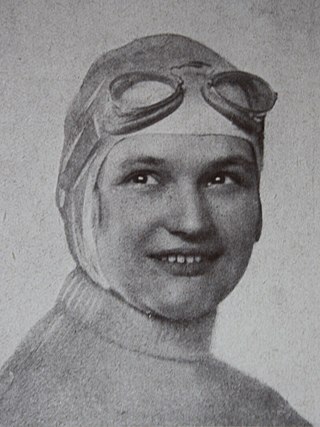
Eliška Junková-Khásová, also known as Elisabeth Junek, was a Czechoslovak automobile racer. She is regarded as one of the most significant drivers in Grand Prix motor racing history, and was the first woman to win a Grand Prix event.
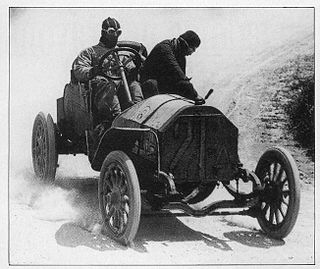
The Targa Florio was a public road endurance automobile race held in the mountains of Sicily near the island's capital of Palermo. Founded in 1906, it was the oldest sports car racing event, part of the World Sportscar Championship between 1955 and 1973. While the first races consisted of a whole tour of the island, the track length in the race's last decades was limited to the 72 km (45 mi) of the Circuito Piccolo delle Madonie, which was lapped 11 times.

Achille Varzi was an Italian racing driver. He is remembered as the chief rival of Tazio Nuvolari, and was the winner of the 1933 Monaco Grand Prix.
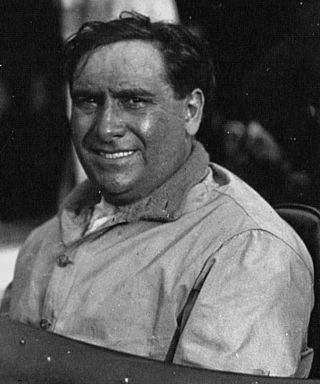
Giuseppe Campari was an Italian opera singer and Grand Prix motor racing driver.

Baconin Borzacchini was an Italian racing driver who often competed under the nom de courseMario Umberto Borzacchini.

The 1936 Grand Prix season was the third year of the 750 kg Formula. The next iteration of the Mercedes-Benz did not prove successful and the team withdrew during the season to instead prepare for the next one. It therefore fell to the resurgent Auto Union team to dominate the racing. In particular, it was their young, new superstar, Bernd Rosemeyer, who mastered the tricky car and who showed superlative skill in wet conditions. Rosemeyer easily won this season's European Championship by winning three of the four Grands Prix.

The Alfa Romeo P3, P3 monoposto or Tipo B was a classic Grand Prix car designed by Vittorio Jano, one of the Alfa Romeo 8C models. The P3 is considered to be the world's first genuine single-seat Grand Prix racing car and was Alfa Romeo's second monoposto after the Tipo A monoposto (1931). It was based on the earlier successful Alfa Romeo P2. Taking lessons learned from that car, Jano went back to the drawing board to design a car that could last longer race distances.

The 1935 Grand Prix season was the second year of the new 750 kg Formula. The success of the previous year encouraged the AIACR to reinitiate the European Championship. It was composed of the seven national Grands Prix and was won by Rudolf Caracciola, driving for the Mercedes-Benz team. The team dominated the season winning five of those Grand Épreuves, as well as four of the other major races of the season. However, in one of the great motor-races in sporting history, Tazio Nuvolari in a Scuderia Ferrari Alfa Romeo beat the combined numbers of the German teams in their home Grand Prix. The season also saw the arrival on the international stage of the bright young talent Bernd Rosemeyer in the Auto Union team.

The 1931 Grand Prix season was a watershed year, with the advent of the AIACR European Championship. After several years of Grand Prix racing in the doldrums with little technical development, 1931 saw new models come from all three main manufacturers: Bugatti, Maserati and Alfa Romeo.

The 1932 Grand Prix season marked the second year of the AIACR European Championship. It saw the debut of Alfa Romeo's sensational new Tipo B and with it, Tazio Nuvolari won the Championship driving for the Alfa Corse works team. The 40-year old Nuvolari won two of the three rounds and was second in the other. Still running to a Formula Libre rules for the cars, the regulations were revised to set the races to be between five and ten hours. However, all three national committees ran their races to the minimum time-limit.

The 1933 Grand Prix season was an intermediate year, as it would be the last season for the current AIACR regulations before a new weight-formula was introduced in 1934. As such, the European Championship was not held and the manufacturers held back on further developments of their existing models. Alfa Romeo, following an Italian government financial bailout and like Mercedes-Benz the previous year, had shut down its Alfa Corse works team. Scuderia Ferrari, their regular customer team took up the role of racing Alfa Romeos and a number of ex-works drivers moved across to join their ranks. They were not allowed, however, to buy the impressive Tipo B that had been so dominant in the previous season.
The 1934 Grand Prix season saw the advent of the new 750 kg Formula. In an effort to curb the danger of rising speeds, the AIACR imposed this upper weight limit that effectively outlawed the large capacity engines. The incumbent manufacturers Alfa Romeo, Maserati and Bugatti had been preparing their new models with varying success – the best of which was the Alfa Romeo Tipo B. However, it was the state-sponsored arrival of the two German teams, Mercedes-Benz and Auto Union, and their innovative and progressive cars that ignited a new, exciting era of motor racing.
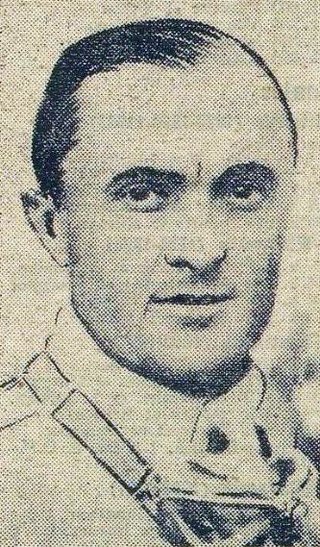
The 1928 Grand Prix season saw the Monegasque driver Louis Chiron, and his Bugatti, take seven Grand Prix victories.

Luigi Arcangeli was an Italian motorcycle and car racer.
The 1929 Grand Prix season was another interim year, where most races were run to Formula Libre rules due to a lack of regulations from the AIACR that would be popular for race organisers and manufacturers. This blurred the line between racing cars and sports cars with both competing in the same races. Bugatti won the major international races, with their drivers Louis Chiron and "W Williams". The Italian Championship proved very competitive, attracting many top drivers. There it was Alfa Romeo, using their 4-year old P2 model that claimed more victories, than their main competition coming from Bugatti and Maserati.
The 1930 Grand Prix season continued the malaise that had taken over the sport. Although there was little technical advance more privateer teams were forming, getting some factory support. The AIACR continued to mandate its fuel-regulated Formula Libre rules. Across the Atlantic, the AAA abandoned the AIACR regulations. Their new regulations were derisively called the “Junk Formula” by purists, opening up to their own version of Formula Libre: with modified stock-standard cars of up to 366 cu in (6-litres) with two seats.

The Tunis Grand Prix or Grand Prix de Tunis was a motor race held in the 1920s and 30s in Tunis, the capital of the African colony of the French protectorate of Tunisia.

The 1933 French Grand Prix was a Grand Prix motor race which was run on 11 June 1933, in Montlhéry, France. Organized by the French Automobile Club, it was XXVII running of the Grand Prix de l'Automobile Club de France. The race, which was held over 40 laps, was won by the Italian driver Giuseppe Campari in a privately entered Maserati. It was to be Campari's final victory, as he was killed just three months later at Monza. Philippe Étancelin and George Eyston, both in privateer Alfa Romeos, finished in second and third, respectively.
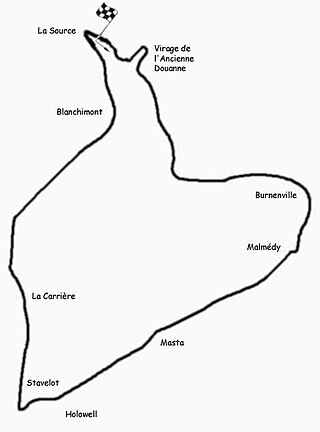
The 1933 Belgian Grand Prix was a Grand Prix motor race held at Spa-Francorchamps on 9 July 1933. The 40-lap race was won by Tazio Nuvolari, of Scuderia Ferrari, driving a Maserati. Second and third were taken by the works Bugatti drivers Achille Varzi and René Dreyfus.